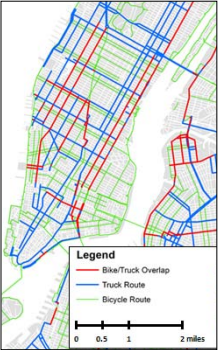News | Freight on Complete Streets
Stop the VideoNews

This article is part of an ongoing series that describes research accomplishments and achievements of the METRANS Transportation Center in recognition of its 20th Anniversary. Dr. Alison Conway is an Associate Professor of Civil Engineering at the City College of New York and the Associate Director for New Initiatives at the Region 2 University Transportation Research Center. She is also an associated faculty member of MetroFreight, a Volvo Research and Educational Foundations Center of Excellence in urban freight. At CCNY, Dr. Conway teaches courses in transportation engineering and planning and conducts research primarily in the areas of commercial freight policy and logistics, sustainable freight transportation, and multi-modal interactions in the urban environment. She currently chairs the TRB Young Members Council and the ASCE Transportation and Development Institute’s Freight and Logistics Committee, and is a member of TRB’s Freight Data, Truck Size and Weight, and Urban Freight Committees.
Freight on Complete Streets
By: Alison Conway
Over the last decade, cities throughout the US have been transforming their streets, repurposing travel and parking space previously dedicated to motor vehicles for use by public transit, active travelers, and local businesses and residents. These changes are expected to yield improvements in air quality, public health and safety, and neighborhood livability. However, during the same period, freight activity in cities has also rapidly evolved. Businesses and residents have quickly become accustomed to receiving near-immediate deliveries of goods when and where they are desired.
A sizable share of commercial deliveries have now been replaced by frequent movements of small shipments to both commercial and residential endpoints. This new model of “last-mile” logistics requires more vehicles traveling to more locations at all hours of the day. Particularly coupled with the shrinking capacities for freight activity brought about by complete streets improvements, this new demand presents a tremendous challenge for cities to accommodate.
During the last five years, with support from the Volvo Research and Educational Foundations, MetroFreight researchers have been investigating the interface between complete streets improvements and freight operations, with aim to provide insights that enable cities to better integrate modern freight activity into livable communities.
An initial study conducted in 2012 by researchers at The City College of New York examined the extent to which New York City’s dedicated bicycle and truck routes now overlap, and identified and quantified both collisions and parking conflicts that occur between commercial vehicles and bicycles in the city. Key findings of the study were that growth in the bicycle network has substantially impacted capacities on truck routes, that collisions between these vehicle types are heavily concentrated on dedicated truck routes, and that many bike lane obstructions by commercial vehicles result from a lack of any reasonable alternative parking location for delivery activity.

By highlighting a common lack of consideration for freight in multimodal street design, these findings inspired the research team to undertake a second project in 2016 to develop guidance on how to accommodate freight and emergency vehicle travel and parking activity when designing complete streets.
This project was funded by the New York State Energy Research and Development Authority (NYSERDA) and conducted in collaboration with the CCNY School of Architecture and the New York City Department of Transportation’s Office of Freight Mobility. Following a global review of challenges and best practices for freight operations in multimodal cities, the research team developed and conducted a web-based survey of 11 medium to very large sized US cities.
This survey identified seven common challenges that these cities face in planning and designing complete streets:
- Selecting an appropriate design vehicle
- Providing adequate space for large vehicle turns
- Reducing conflicts with vulnerable roadway users
- Safely reducing large vehicle speeds
- Providing adequate space for parking, loading, and emergency response operations
- Providing curb and building access
The team then developed a comprehensive illustrated guidebook outlining design, operational, educational, and policy approaches to address each challenge. In addition, they also developed presentation modules that can be used in an academic classroom or professional development training to educate planners and design engineers about freight and emergency vehicle fundamentals. Recommendations from the guidebook are currently being integrated into the next update to the New York City Street Design Manual.
News Archive
- December (1)
- November (6)
- October (4)
- September (2)
- August (3)
- July (4)
- June (3)
- May (7)
- April (8)
- March (11)
- February (8)
- January (7)
- December (7)
- November (8)
- October (11)
- September (11)
- August (4)
- July (10)
- June (9)
- May (2)
- April (12)
- March (8)
- February (7)
- January (11)
- December (11)
- November (5)
- October (16)
- September (7)
- August (5)
- July (13)
- June (5)
- May (5)
- April (7)
- March (5)
- February (3)
- January (4)
- December (4)
- November (5)
- October (5)
- September (4)
- August (4)
- July (6)
- June (8)
- May (4)
- April (6)
- March (6)
- February (7)
- January (7)
- December (8)
- November (8)
- October (8)
- September (15)
- August (5)
- July (6)
- June (7)
- May (5)
- April (8)
- March (7)
- February (10)
- January (12)















